We headed along the old city wall, passed the Drommedaris, and soon we were sitting on a train speedily heading towards Amsterdam. The train was, as usual, spotless, quiet and punctual. The rural scenes started to give way to built up settlements, and eventually we were speeding through the urban sprawl of the capital.
As soon as we exited the station, we knew we were in a large, lively environment. Folk streamed in all directions. Cycles sped hither and thither with seemingly no regard for pedestrians or vehicles for that matter. And just to keep us on our toes, cars, busses, trams and a host of commercial vehicles threatened to strike us at any moment.
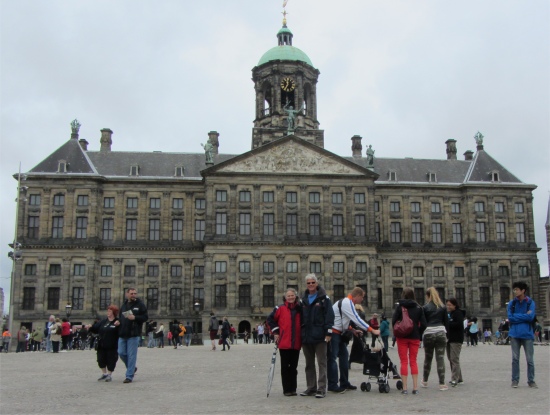 Royal Palace |
That done, we headed down Damrak, a very touristy thoroughfare much like Piccadilly Circus in London, with wide pavements, and tacky shops waiting to relieve the proliferation of visitors of their hard earned cash. I guess there are streets like this in all major cities of the world.
Looking about us, we could see a mix of modern and old architectures. Amsterdam was founded as a fishing village around the thirteenth century, and developed around a dam in the Amstel River. During the 14th, but especially the 15th century, Amsterdam underwent a rapid development, which laid the foundation for the Golden Age.
The period 1585-1672, the Golden Age, was the hey-day of Amsterdam's commercial success. At the time Amsterdam was the stable market of the world. During this period the characteristic Amsterdam cityscape developed; the 1613 and 1663 urban expansions still determine the city's characteristic appearance. Some of the most important historic buildings date back to this period, such as the town hall in the Dam Square (now the Royal Palace)
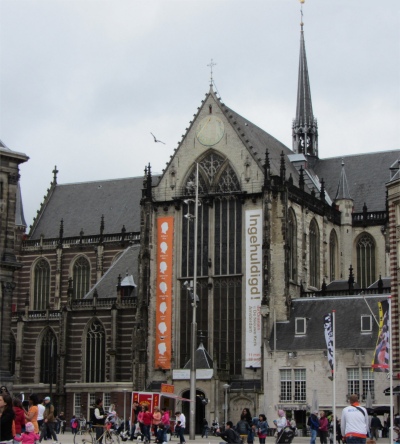 Nieuwe Kerk |
In 1795 the government of the patrician oligarchies was overthrown and the old Republic ceased to exist. Soon the French were to occupy the country. During the period 1795-1813 Amsterdam suffered badly from the economic recession, a state of affairs reflected by the stagnation of the demographic development.
The period 1813-1940 is marked by economic recovery and, from 1870 onwards, by expansion. The increasing wealth brought about a rapid population growth. This development was primarily the result of the Industrial Revolution which triggered off a New Golden Age. The city now ventured into the area beyond the Singelgracht. Large poorly built working-class neighbourhoods were built. The period 1920-1940 was a time of economic recession. This was also the period of large-scale damage to the historical city centre; canals were filled in and new traffic breakthroughs were realised.
We emerged from the Damrak into Dam Square, a busy plaza that is considered to be the birthplace of the city, and is the site where the river Amstel was dammed, allowing the town to be built on dry land. The Dam Square with its very central location, was a popular congregating place for both tourists and locals, with lots of shops and restaurants nearby.
The square contained attractions such as the Royal Palace, the Nieuwe Kerk and the National Monument. The Royal Palace was once called the Eighth Wonder of the World. It was built between 1648 and 1665, and was originally intended for use as a city hall. The Royal Palace was built upon a former riverbed, using 13,659 wooden piles to create a solid surface to build upon. The building officially became the Royal Palace in the 1800s, when Louis Napoleon wanted to leave The Hague after the death of his son. The Royal Palace is still used for coronations and other special Royal ceremonies to this day.
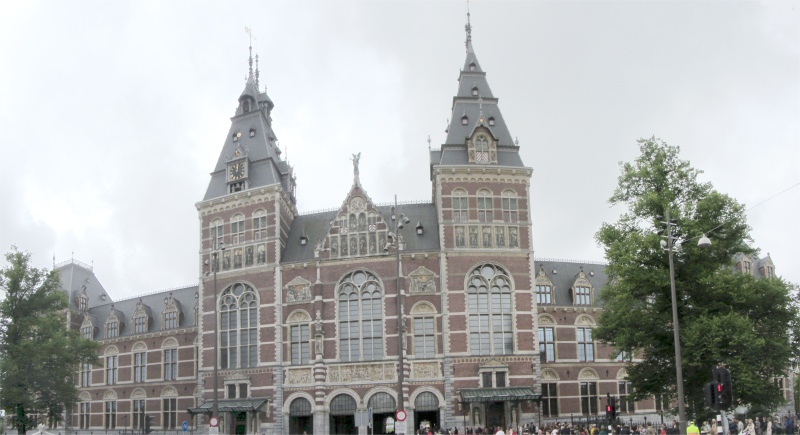 Rijksmuseum |
Despite having tickets, we had to join a long queue, a very long queue to enter the museum. Standing in this queue was soul destroying, progress was less than snail pace. On our funeral march along this never ending line we passed decaying corpses, and on latter stretches, skeletons littered the margin of the queue. How could such an important museum get this so totally wrong. Here we stood in a long line of hundreds of people, all just wasting our time, when we could have been enjoying other attractions in the city and pouring more money into the city's coffers. Why had they not grasped the concept of timed tickets?
 Carved Stone in a House Wall |
After almost two hours, we finally entered this hallowed building. I was soon collared and politely asked to leave my backpack in the cloakroom. To my joy, there was only a half hour wait in that queue.
The Rijksmuseum (The State Museum) has existed for more than two hundred years and is considered by many to be the "national treasure of the Netherlands". Like most of continental Europe's great museums, the Rijksmuseum has at its core a Royal Collection of 200 paintings and artefacts that were first displayed publicly in a national museum of culture in The Hague in 1800. Since then, it moved several times before being established in Amsterdam (1808) by the decree of the King of the Netherlands, Louis Bonaparte, brother of Napoleon. Since then it steadily expanded through donations and acquisitions. In 1885 the Rijksmuseum moved to the beautiful building in which we now found ourselves, designed by the Dutch architect Petrus J.H. Cuypers. It was built in the then fashionable Dutch neo-Renaissance style, using historical neo-Gothic elements in it form and decoration.
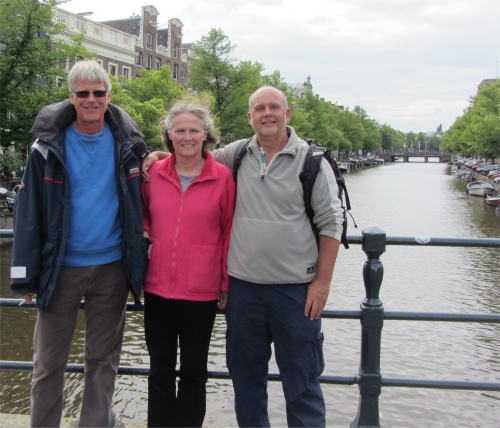 Pity You Can't See Our Clogs |
At its heart is the Gallery of Honour at the centre of the building, which focuses on "The Night Watch" by Rembrandt van Rijn, and holds most of the collection's famous paintings.
We were awestruck with the quality, quantity and beauty of the objects in the museum, it was all a delight to set our eyes upon. However, the museum was large, and after a few hours we were saturated with art and found it hard to take in more.
 Rembrandt and The Night Watch in Rembrandtplein |
We steered our weary feet back along canal sides to the city centre. Cafes, bars, restaurants and buskers marked the more touristy areas of the city. Rembrandtplein was ruled over by a cast iron statue of Rembrandt in a rather casual pose, overlooking the many visitors who had headed to the square for fun or relaxation. Rembrandtplein or Rembrandt Square, originally known as the Botermarkt (Butter Market), was established in 1668 and built from the remnants of the old city port. As part of the celebration of the artist's 400th birthday in 2006, a bronze-cast representation of his most famous painting, "The Night Watch", by Russian artists Mikhail Dronov and Alexander Taratynov, was displayed around the statue.
A collection of art stalls were congregated around the square with their budding owners nonchalantly sitting around hoping to snare a buyer. Outside a roadside bar, an ensemble of brass musicians played, sung, danced and entertained a continuous flow of tourists, and excellent musicians they were too.
We followed more canals, passing coffee shops with strange, weedy, smells emanating from their smoky depths, and arrived at the Nieuwmarkt, a large, busy square with the imposing Waag squatting in it. Wherever you go in the Netherlands you'll always come across a Waag (weighing house).
 "I'm a Handsome Geezer" ............................................... "Can't Wait to get My Hands on Him" ........................................................ "Romance in Rembrandtplein" |
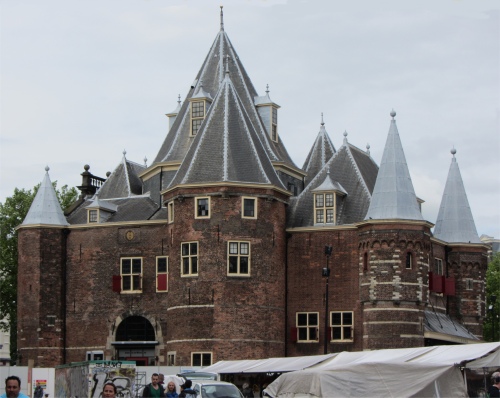 Waag |
But time moved on, and we left this little corner of Amsterdam and headed back to the central station. We passed through an area containing shop windows with bizarre merchandise of all shapes and sizes in them. Young men seemed to have a fascination and fits of giggles around these shop windows, but most folk simply walked past without paying heed, just going about their daily business.
Once back in Enkhuizen, it was getting late, so we decided to visit the restaurant again where we had been the previous two evenings. Yes, it was that good. Again, we were warmly greeted by the staff, and this evening the head waiter approached to inform us that since this was our third visit, the chef would prepare a surprise meal for us, which was not available on the menu. All we had to do was choose if we wanted fish or meat for a starter, and likewise for the main course. I chose fish for both, Rex opted for meat for both, and Meryl chose a fish starter and meat main course.
My starter comprised: smoked salmon on a salad bed, smoked eel, Waddenzee prawns, smoked mackerel, tuna and a small glass of bouillabaisse. Main course was a sea of sole filet, tuna steak and ratatouille. To share was salad, small roast potatoes, vegetables and the usual bowl of frites that we ignored.
Whilst enjoying this feast, the lady chef appeared to check all was hunky dory. The food in this restaurant was superb, as was the service; I would recommend it to anyone.
We all slept well that night.
